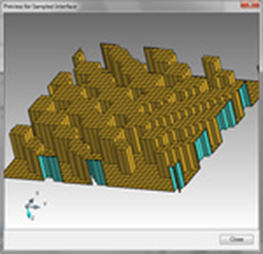
quantized diffractive
diffuser, beam shaper
or splitter
diffuser, beam shaper
or splitter

diffractive beam
homogenization-splitting-shaping
homogenization-splitting-shaping
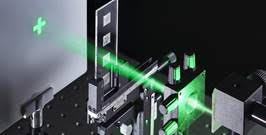
diffractive beam shaper
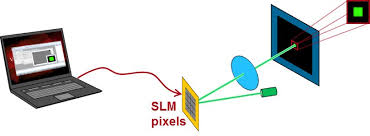
spatial light modulator
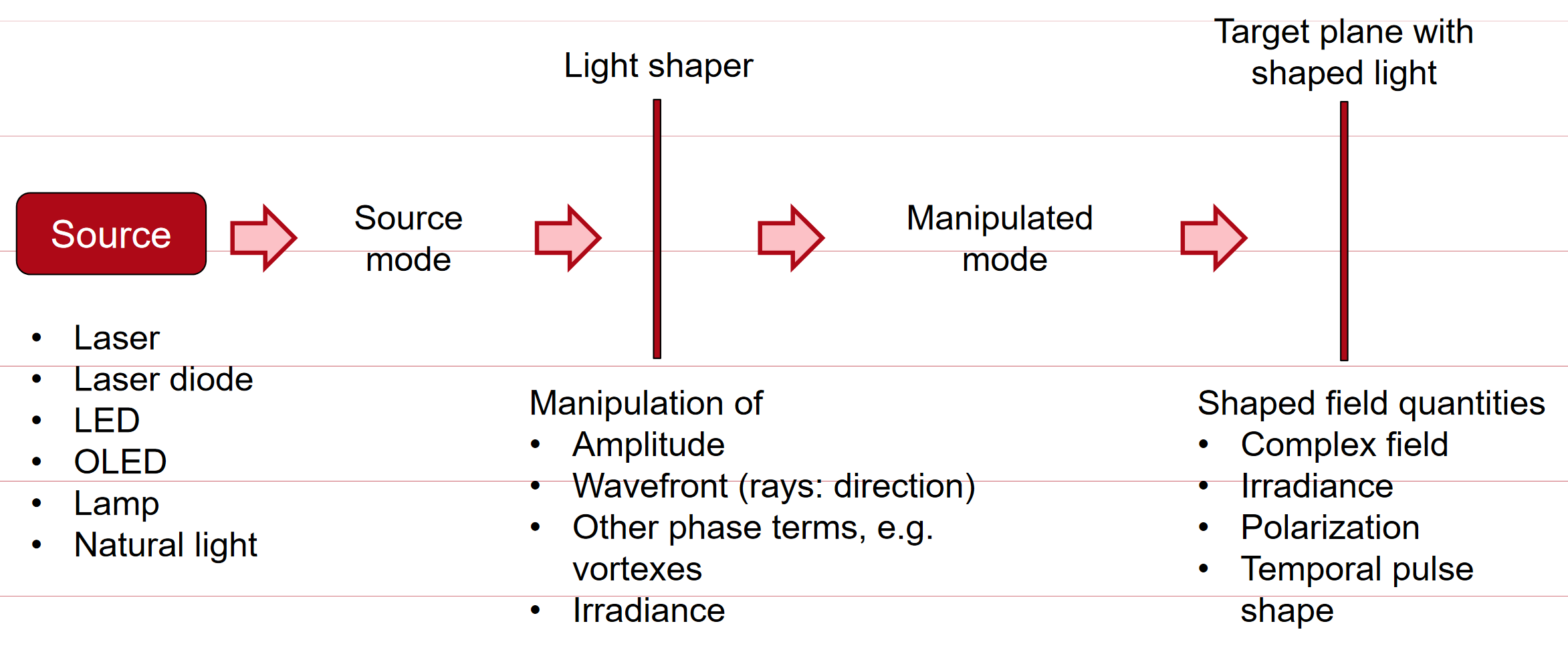
beam shaper design concept

target pattern input
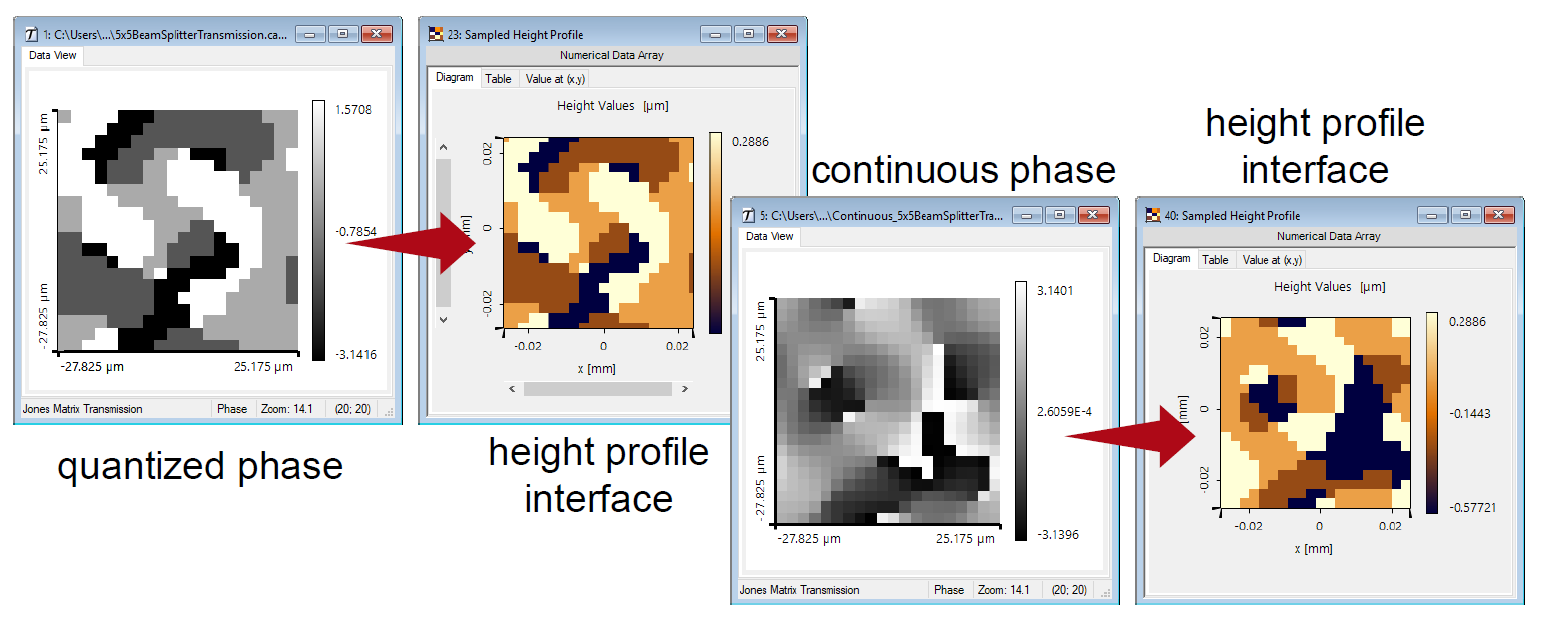
quantized phase and heights
continuous phase and heights
continuous phase and heights

phase unwrapping
Beam shapers, beam splitters, diffusers, CGHs, SLMs
Diffractive Optics Toolbox Silver, or
Diffractive Optics Gold -
Gold includes diffractive lenses and metalenses,
Either Silver or Gold version works with:
VirtualLab Fusion Basic, or
VirtualLab Fusion Advanced -
Advanced includes FMM/RCWA for rigorous grating analysis
The VirtualLab Fusion Diffractive Optics Toolbox program is for simulating and designing diffractive diffusers, beam shapers, beam homogenizers, beam splitters / beam combiners and computer-generated holograms.
It can also simulate Spatial Light Modulators.
Either the Silver or Gold version can be used for these DOEs.
The Gold version is also for designing diffractive lenses and metalenses.
For information on the Gold Version, click on diffractive and metalenses
The target pattern input for diffractive pattern-shaping diffusers can be bitmap (bmp, jpg, png) files, ASCII 2D matrix files, or user-defined harmonic field files.
Other input parameters include wavelength, input beam diameter, divergence, etc.
Then, multiple potential optical designs for DOEs are created by Iterative Fourier Transform Algorithm (IFTA). Merit function results are calculated and logged for each IFTA design, to enable the user to select a result for creating a physical structure design.
For paraxial designs the chosen DOE physical structure is then computed with Thin Element Approximation (TEA). TEA assumes that height profile is proportional to the transmission phase. DOE structures can be continuous or quantized.
For DOEs with feature sizes close to the wavelength and large diffraction angles, such as high NA diffractive beam splitters, VirtualLab Fusion uses Fourier Modal Method (FMM/RCWA) to rigorously analyze the non-paraxial design. This can take into account such merit functions as diffraction efficiency and uniformity error. For example, zeroth order diffraction can be reduced to improve uniformity.
For information on high NA applications contact HMS Technology Sales
Session Editors (Wizards)
Besides manual workflow, the Diffractive Optics Toolbox includes session editors (wizards) to guide users through the workflow for pattern-generating diffusers, rectangular diffusers, eliptical diffusers, and beam splitters.
Input beam parameters (wavelength, beam size, divergence, et) and desired output field parameters are are entered. The pattern-generating diffuser workflow accepts target-pattern input of bitmap (bmp, jpg, png) files, ASCII 2D matrix files, and user-defined harmonic field files.
Next VirtualLab uses Iterative Fourier Transform Algorithm (IFTA) to create and optimize multiple potential DOE designs.
Then merit function results for each design are logged, so the desired optical design can be selected for physical structure design by Thin Element Approximation (TEA) for paraxial propagation or for further Fourier Modal Method (FMM) rigorous analysis for high NA applications.
Parameter Run
The final structure can be optimized or toleranced by the Parameter Run in the VirtualLab Fusion Diffractive Optics Toolbox program.
Physical parameters can be varied and merit function results can be calculated.
Minimum and maximum ranges for each parameter can be specified, as well as the number of steps to vary in each range.
Analysis results are stored in XML files.
For more information on programming, click on: Programming
The Parameter Run is important for maximizing efficiency, optimizing high NA applications, as well as for tolerancing,
Fabrication files
The final DOE design can be exported to fabrication files in several formats, including: GDSII, CIF, Bitmap, ASCII/.csv, Point-Cloud, STL.
The Diffractive Optics Toolbox works along with the Starter Toolbox (in VirtualLab Fusion Basic or Advanced) to include all the optical elements in a lightpath, in addition to the DOE or SLM.
The Starter Toolbox can include sources, all optical elements, detectors and analyzers. It includes parametric optimization for the entire optical system, such as distances, positions, sizes, angles, wavelengths, and many more parameters.
VirtualLab Fusion is an integrated software suite of programs for connecting solvers and propagation methods for all the microscale and macroscale components in an optical system.
For shaping beams from partially coherent sources, such as monochromatic and white LEDs, VirtualLab Fusion offers the Light Shaping Toolbox. This creates arrays of prisms, gratings or mirrors.
For information click on Light Shaping Toolbox
Diffractive Optics Gold -
Gold includes diffractive lenses and metalenses,
Either Silver or Gold version works with:
VirtualLab Fusion Basic, or
VirtualLab Fusion Advanced -
Advanced includes FMM/RCWA for rigorous grating analysis
The VirtualLab Fusion Diffractive Optics Toolbox program is for simulating and designing diffractive diffusers, beam shapers, beam homogenizers, beam splitters / beam combiners and computer-generated holograms.
It can also simulate Spatial Light Modulators.
Either the Silver or Gold version can be used for these DOEs.
The Gold version is also for designing diffractive lenses and metalenses.
For information on the Gold Version, click on diffractive and metalenses
The target pattern input for diffractive pattern-shaping diffusers can be bitmap (bmp, jpg, png) files, ASCII 2D matrix files, or user-defined harmonic field files.
Other input parameters include wavelength, input beam diameter, divergence, etc.
Then, multiple potential optical designs for DOEs are created by Iterative Fourier Transform Algorithm (IFTA). Merit function results are calculated and logged for each IFTA design, to enable the user to select a result for creating a physical structure design.
For paraxial designs the chosen DOE physical structure is then computed with Thin Element Approximation (TEA). TEA assumes that height profile is proportional to the transmission phase. DOE structures can be continuous or quantized.
For DOEs with feature sizes close to the wavelength and large diffraction angles, such as high NA diffractive beam splitters, VirtualLab Fusion uses Fourier Modal Method (FMM/RCWA) to rigorously analyze the non-paraxial design. This can take into account such merit functions as diffraction efficiency and uniformity error. For example, zeroth order diffraction can be reduced to improve uniformity.
For information on high NA applications contact HMS Technology Sales
Session Editors (Wizards)
Besides manual workflow, the Diffractive Optics Toolbox includes session editors (wizards) to guide users through the workflow for pattern-generating diffusers, rectangular diffusers, eliptical diffusers, and beam splitters.
Input beam parameters (wavelength, beam size, divergence, et) and desired output field parameters are are entered. The pattern-generating diffuser workflow accepts target-pattern input of bitmap (bmp, jpg, png) files, ASCII 2D matrix files, and user-defined harmonic field files.
Next VirtualLab uses Iterative Fourier Transform Algorithm (IFTA) to create and optimize multiple potential DOE designs.
Then merit function results for each design are logged, so the desired optical design can be selected for physical structure design by Thin Element Approximation (TEA) for paraxial propagation or for further Fourier Modal Method (FMM) rigorous analysis for high NA applications.
Parameter Run
The final structure can be optimized or toleranced by the Parameter Run in the VirtualLab Fusion Diffractive Optics Toolbox program.
Physical parameters can be varied and merit function results can be calculated.
Minimum and maximum ranges for each parameter can be specified, as well as the number of steps to vary in each range.
Parameters can be varied in four ways:
- standard mode: linear variation of selected parameters between minimum and maximum values
- programmable mode: customized parameter values per variation step. A table with the parameter values per variation step is filled by a program snippet
- scanning mode: scan of all possible parameter combinations
- random mode: random Monte Carlo variation of parameters between minimum and maximum values
Analysis results are stored in XML files.
For more information on programming, click on: Programming
The Parameter Run is important for maximizing efficiency, optimizing high NA applications, as well as for tolerancing,
Fabrication files
The final DOE design can be exported to fabrication files in several formats, including: GDSII, CIF, Bitmap, ASCII/.csv, Point-Cloud, STL.
The Diffractive Optics Toolbox works along with the Starter Toolbox (in VirtualLab Fusion Basic or Advanced) to include all the optical elements in a lightpath, in addition to the DOE or SLM.
The Starter Toolbox can include sources, all optical elements, detectors and analyzers. It includes parametric optimization for the entire optical system, such as distances, positions, sizes, angles, wavelengths, and many more parameters.
VirtualLab Fusion is an integrated software suite of programs for connecting solvers and propagation methods for all the microscale and macroscale components in an optical system.
For shaping beams from partially coherent sources, such as monochromatic and white LEDs, VirtualLab Fusion offers the Light Shaping Toolbox. This creates arrays of prisms, gratings or mirrors.
For information click on Light Shaping Toolbox
To contact HMS Technology Sales for more information click here